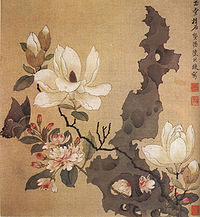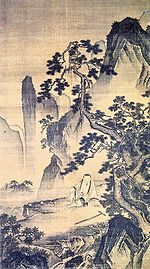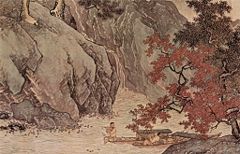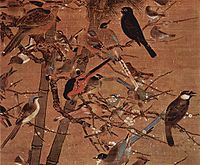
Ming Dynasty painting
Encyclopedia

Ming Dynasty
The Ming Dynasty, also Empire of the Great Ming, was the ruling dynasty of China from 1368 to 1644, following the collapse of the Mongol-led Yuan Dynasty. The Ming, "one of the greatest eras of orderly government and social stability in human history", was the last dynasty in China ruled by ethnic...
(1368-1644), Chinese painting developed greatly from the achievements in painted art during the earlier Song Dynasty
Song Dynasty
The Song Dynasty was a ruling dynasty in China between 960 and 1279; it succeeded the Five Dynasties and Ten Kingdoms Period, and was followed by the Yuan Dynasty. It was the first government in world history to issue banknotes or paper money, and the first Chinese government to establish a...
and Yuan Dynasty
Yuan Dynasty
The Yuan Dynasty , or Great Yuan Empire was a ruling dynasty founded by the Mongol leader Kublai Khan, who ruled most of present-day China, all of modern Mongolia and its surrounding areas, lasting officially from 1271 to 1368. It is considered both as a division of the Mongol Empire and as an...
. The painting techniques which were invented and developed before the Ming period became classical during this period. More colours were used in painting during the Ming Dynasty. Seal brown
Seal brown
Seal brown is a rich dark brown color, resembling the color of the dyed fur from the fur seal.-Usage:The specifications for the U.S. Army Air Corps Type A-2 jacket , adopted in 1931 and the most familiar among all leather flight jackets, stated that it should be made of horsehide tanned to seal brown...
became much more widely used, and even over-used during this period. Many new painting skills/techniques were innovated and developed, calligraphy
Calligraphy
Calligraphy is a type of visual art. It is often called the art of fancy lettering . A contemporary definition of calligraphic practice is "the art of giving form to signs in an expressive, harmonious and skillful manner"...
was much more closely and perfectly combined with the art of painting. Chinese painting reached another climax in the mid-, late- Ming Dynasty. The painting was derived in a broad scale, many new schools were born, and many outstanding masters emerged.
Development
Early Ming period
The painting schools of the Yuan Dynasty
Yuan Dynasty
The Yuan Dynasty , or Great Yuan Empire was a ruling dynasty founded by the Mongol leader Kublai Khan, who ruled most of present-day China, all of modern Mongolia and its surrounding areas, lasting officially from 1271 to 1368. It is considered both as a division of the Mongol Empire and as an...
still remained in the early Ming period but quickly declined or changed their styles. The painting styles which were developed and matured during the Yuan period, still heavily influenced the early Ming painting. But new schools of painting were born and grew. Zhe School
Zhe School
The Zhe School was a school of painters, and part of the Southern School, which thrived during the Ming dynasty. The school was led by Dai Jin. The "Zhe" of the name refers to Dai Jin's home province - Zhejiang...
and the school which was supported by the royal court (Yuanti School) were the dominant schools during the early Ming period. The scholar-artist style of painting (Renwen Painting, in Chinese: 人文画) became more popular. Both these two new schools were heavily influenced by the traditions of both the Southern Song painting academy and the Yuan scholar-artist.
Mid Ming period
About 1465~1566, from the Chenghua
Chenghua
Chenghua may refer to:*Chenghua Emperor, Chinese emperor of Ming Dynasty*Chenghua District, district in Chengdu, Sichuan, China...
Era (成化) to Jiajing Era (嘉靖).

The Wumen painters they mainly inherited the tradition of Yuan scholar-artist style of painting (Renwen painting, 人文畫) and further developed this style into a peak. Wumen School was a large group of people, including teacher-student relationship (e.g. Shen Zhou was the teacher of Tang Yin
Tang Yin
Tang Yin , better known by his courtesy name Tang Bohu , was a Chinese scholar, painter, calligrapher, and poet of the Ming Dynasty period whose life story has become a part of popular lore...
, Wen Zhengming
Wen Zhengming
Wen Zhengming was a leading Ming Dynasty painter, calligrapher, and scholar.Born in present-day Suzhou, he claimed to be a descendant of the Song Dynasty prime minister and patriot Wen Tianxiang. Wen’s family was originally from Hengyang, Hunan, where his family had established itself shortly...
and so on) and family relationship (e.g. Wen family, including painters Wen Zhengming
Wen Zhengming
Wen Zhengming was a leading Ming Dynasty painter, calligrapher, and scholar.Born in present-day Suzhou, he claimed to be a descendant of the Song Dynasty prime minister and patriot Wen Tianxiang. Wen’s family was originally from Hengyang, Hunan, where his family had established itself shortly...
, Wen Jia (文嘉), Wen Boren (文伯仁) and so on).

Shaoxing
Shaoxing is a prefecture-level city in northeastern Zhejiang province, People's Republic of China. Located on the south bank of the Qiantang River estuary, it borders Ningbo to the east, Taizhou to the southeast, Jinhua to the southwest, and Hangzhou to the west. It was once known as "越"...
, Zhejiang Province, he developed a lot the enjoyable style of Chinese painting (Xieyi painting, 寫意畫), especially the geart enjoyable style (Daxieyi, 大寫意). As an outstanding scholar, his accomplishments are mainly in the field of scholar-artist painting, especially in bird-and-flower painting
Bird-and-flower painting
Bird-and-flower painting is a kind of Chinese painting named after its subject matter. Normally, most bird-and-flower paintings belong to the scholar-artist style of Chinese painting....
.
Chen Chun (陳淳), although he followed the teaching from Wumen School of painting during his early years, he set up his own style in Shan-shuin painting (landscape painting, 山水畫); he formally introduced the enjoyable style into the Chinese landscape painting, and had his own innovation in ink and wash painting, especially in his long suit—the landscape painting.
Late Ming period
About 1567~1644, from the Jiajing Era (嘉靖) to Chongzhen Era (崇祯).
Songjiang School and Huating School were born and developed, they formed rudiment of latterly coming Shanghai School.

Schools and painters
- Zhejiang School of Painting (浙派, full name in Chinese: 浙江画派)
- Jiangxia School (江夏画派)
- Wulin School or Post-Zhejiang School (武林画派, or 后浙派)
Dai Jin (戴进), Wu Wei (吴伟), Lan Ying (蓝瑛) (Lan family)
The core place for this school was Hangzhou in Zhejiang Province. Jiangxia School from Hubei Province was a branch of this school. Dai Jin was the founder of this school, and he also kept a very close relationship with the Yuanti School.

West Lake
Xī Hú is a famous fresh water lake located in the historic center of Hangzhou, the capital of Zhejiang province in eastern China. The lake is divided by the causeways of Sū Tí , Bái Tí , and Yánggōng Tí...
.
Most of the painters from this school, they are Zhejiang natives.
- Yuanti School (院体画派)
Lin Liang (林良), Lv Ji (吕纪)
This school was organized and supported by the Ming central government, and it served for Ming royal court. The activity center for this school first was in Nanjing and then went to Beijing because of the change of Ming's capital. The
- Wumen School (吴门画派)
Tang Yin
Tang Yin
Tang Yin , better known by his courtesy name Tang Bohu , was a Chinese scholar, painter, calligrapher, and poet of the Ming Dynasty period whose life story has become a part of popular lore...
(唐寅), Wen Zhengming
Wen Zhengming
Wen Zhengming was a leading Ming Dynasty painter, calligrapher, and scholar.Born in present-day Suzhou, he claimed to be a descendant of the Song Dynasty prime minister and patriot Wen Tianxiang. Wen’s family was originally from Hengyang, Hunan, where his family had established itself shortly...
(文征明), Shen Zhou
Shen Zhou
Shen Zhou , courtesy name Qinan , was a Chinese painter in the Ming dynasty.-Life:Shen Zhou was born into a wealthy family in Xiangcheng, near the thriving city of Suzhou, in the Jiangsu province, China...
(沈周), Qiu Ying
Qiu Ying
Qiu Ying was a Chinese painter who specialized in the gongbi brush technique.Qiu Ying's courtesy name was Shifu , and his pseudonym was Shizhou . He was born to a peasant family in Taicang and studied painting under Zhou Chen in Suzhou...
(仇英), Zhou Chen (周臣), Wen Jia (文嘉)
The primary location for this school was Suzhou
Suzhou
Suzhou , previously transliterated as Su-chou, Suchow, and Soochow, is a major city located in the southeast of Jiangsu Province in Eastern China, located adjacent to Shanghai Municipality. The city is situated on the lower reaches of the Yangtze River and on the shores of Taihu Lake and is a part...
, whose literary name was Wumen (吴门). Tang Yin, Wen Zhengming, Shenzhou and Qiu Ying, these four painters also were regarded as the "Big Four of the Ming Period" in Ming period painting.
- Xieyi Huaniao (写意花鸟)
Xu Wei
Xu Wei
Xu Wei was a Ming Chinese painter, poet and dramatist famed for his artistic expressiveness. Revolutionary for its time, his painting style influenced and inspired countless subsequent painters, such as Bada Shanren, the Eight Eccentrics of Yangzhou, and the modern masters Wu Changshuo and Qi...
(徐渭)
- Xieyi Shangshui (写意山水)
Chen chun (陈淳)
- Songjiang School (松江画派)
Dong Qichang
Dong Qichang
Dong Qichang , courtesy name Xuanzai , was a Chinese painter, scholar, calligrapher, and art theorist of the later period of the Ming Dynasty.-Painter:...
(董其昌)
The core place for this school was in the southern part of Jiangsu Province at that time, but now part of Shanghai
Shanghai
Shanghai is the largest city by population in China and the largest city proper in the world. It is one of the four province-level municipalities in the People's Republic of China, with a total population of over 23 million as of 2010...
. During the late Ming Dynasty, the Songjiang School rivaled Wumen, particularly in generating new theories of painting.
- Huating School (华亭画派)
Zhao Zuo (赵左)
This school is close to Songjiang School.
- Susong School (苏松画派)
This school is similar to Songjiang School.
Influence
Influence in Japan
Japanese people
The are an ethnic group originating in the Japanese archipelago and are the predominant ethnic group of Japan. Worldwide, approximately 130 million people are of Japanese descent; of these, approximately 127 million are residents of Japan. People of Japanese ancestry who live in other countries...
Zen
Zen
Zen is a school of Mahāyāna Buddhism founded by the Buddhist monk Bodhidharma. The word Zen is from the Japanese pronunciation of the Chinese word Chán , which in turn is derived from the Sanskrit word dhyāna, which can be approximately translated as "meditation" or "meditative state."Zen...
monk painter Sesshū Tōyō
Sesshu Toyo
was the most prominent Japanese master of ink and wash painting from the middle Muromachi period. He was born into the samurai Oda family , then brought up and educated to become a Rinzai Zen Buddhist priest...
(Japanese: 雪舟等楊) travelled to Ming China, and stayed for about 10 years in Ming China learning painting. He was heavily influenced by the ink and wash painting, Zhejiang School of painting and the Yuanti School of painting.
He resided in Tiantong Temple (Chinese: 天童寺) in Mingzhou (明州, now Ningbo
Ningbo
Ningbo is a seaport city of northeastern Zhejiang province, Eastern China. Holding sub-provincial administrative status, the municipality has a population of 7,605,700 inhabitants at the 2010 census whom 3,089,180 in the built up area made of 6 urban districts. It lies south of the Hangzhou Bay,...
), and also spent time in Beijing in the royal palace (Forbidden City
Forbidden City
The Forbidden City was the Chinese imperial palace from the Ming Dynasty to the end of the Qing Dynasty. It is located in the middle of Beijing, China, and now houses the Palace Museum...
). Before he went to Ming China, he studied Song
Song Dynasty
The Song Dynasty was a ruling dynasty in China between 960 and 1279; it succeeded the Five Dynasties and Ten Kingdoms Period, and was followed by the Yuan Dynasty. It was the first government in world history to issue banknotes or paper money, and the first Chinese government to establish a...
and Yuan
Yuan Dynasty
The Yuan Dynasty , or Great Yuan Empire was a ruling dynasty founded by the Mongol leader Kublai Khan, who ruled most of present-day China, all of modern Mongolia and its surrounding areas, lasting officially from 1271 to 1368. It is considered both as a division of the Mongol Empire and as an...
styles of painting (Chinese/Japanese: 宋元山水畫派) in Japan, and wanted to seek for the very origin of the Chinese painting
Chinese painting
Chinese painting is one of the oldest continuous artistic traditions in the world. The earliest paintings were not representational but ornamental; they consisted of patterns or designs rather than pictures. Early pottery was painted with spirals, zigzags, dots, or animals...
and the real spirit inside of the Chinese art
Chinese art
Chinese art is visual art that, whether ancient or modern, originated in or is practiced in China or by Chinese artists or performers. Early so-called "stone age art" dates back to 10,000 BC, mostly consisting of simple pottery and sculptures. This early period was followed by a series of art...
.
After returning to Japan
Japan
Japan is an island nation in East Asia. Located in the Pacific Ocean, it lies to the east of the Sea of Japan, China, North Korea, South Korea and Russia, stretching from the Sea of Okhotsk in the north to the East China Sea and Taiwan in the south...
, Sesshū Tōyō set up his school and further developed his own style of painting (漢畫派), a style mixed with the Japanese native traditional elements, and became the most celebrated master of painting in his era in Japan, continuing to heavily affect Japanese history to the present day.
Influence in Qing Dynasty painting
Ming Dynasty painting provided the basis for early Qing Dynasty painting, from skills, style, subjects and theoretical basis. The concept of Northern and Southern Schools, developed by Dong Qichang in the late Ming period, influenced the more academic formal painters, such as Wang Yuanqi
Wang Yuanqi
Wang Yuanqi was a Chinese painter of the Qing dynasty.Wang was born in Taicang in the Jiangsu province and tutored in painting by his grandfather Wang Shimin . His style name was 'Mao-ching ' and his sobriquet was ' Lu-t'ai'. Wang is a member of the Four Wangs and Six Masters of the early Qing...
well as providing an inspiration for daring originality for the
"Individualist" painters, such as Kun Can
Kun Can
Kūn Cán was a Chinese painter from Hunan who spent most of his life in Nanjing. He became a Chan Buddhism monk at an early age and in Nanjing was abbot of a monastery on Niushou Shan. His style of landscape painting was influenced by Wang Meng and he is one of the Four Monk Masters in the early...
and Shitao
Shitao
Shi Tao ; , born Zhu Ruoji was a Chinese landscape painter and poet during the early Qing Dynasty .Born in Quanzhou County in Guangxi province, Shi Tao was a member of the Ming royal house. He narrowly avoided catastrophe in 1644 when the Ming Dynasty fell to invading Manchurians and civil rebellion...
.
See also
- Chinese artChinese artChinese art is visual art that, whether ancient or modern, originated in or is practiced in China or by Chinese artists or performers. Early so-called "stone age art" dates back to 10,000 BC, mostly consisting of simple pottery and sculptures. This early period was followed by a series of art...
- Chinese paintingChinese paintingChinese painting is one of the oldest continuous artistic traditions in the world. The earliest paintings were not representational but ornamental; they consisted of patterns or designs rather than pictures. Early pottery was painted with spirals, zigzags, dots, or animals...
- Ming DynastyMing DynastyThe Ming Dynasty, also Empire of the Great Ming, was the ruling dynasty of China from 1368 to 1644, following the collapse of the Mongol-led Yuan Dynasty. The Ming, "one of the greatest eras of orderly government and social stability in human history", was the last dynasty in China ruled by ethnic...
External links
- Chinese Civilization: Ming Dynasty painting Video on The China Times
- Famous Ming Dynasty Painters and Galleries at China Online Museum

